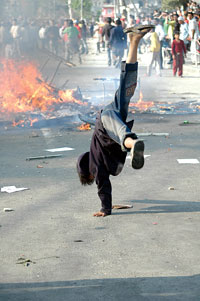|
|
Very late in the modern era, long after other countries of Southasia had experienced their uplifting cathartic moments, Nepalis by the millions stood up against feudalism.
People Power simultaneously pushed back a despotically inclined king making space for pluralism and created the conditions for peace. The mission now is to bring the Maoists in from the jungles while ensuring that kingship is forever barred from mischief.
The Kathmandu Spring suddenly turned into a people's movement of colossal proportions fuelled by the scorn Gyanendra continuously heaped upon the citizenry. Suddenly, the weakened, unarmed middle ground represented by the political parties and civil society gained the upper hand. Meanwhile, a hopefully chastened Maoist leadership saw a nonviolent mass movement achieve what 10 years of their war had failed at.
A menacing autocrat who sought to rule on the basis of dynastic right, outright misrepresentation and military might, Gyanendra was incapable of acknowledging the political maturity of the people. Taking energy from an insular, self-serving Kathmandu Valley upper class equally contemptuous of the political parties, he began appointing prime ministers at will in October 2002 and finally took over as head of government on 1 February 2005.
Gyanendra's excuse for his army-assisted takeover was to fight the insurgency but the intent was to maintain himself as a corrupt all-powerful autocrat. His worst act was to militarise an innocent society, already devastated by years of insurgency. Fortunately, despite the worst of intentions this man did not have the intellectual or organisational skills to run a police state.
This empowerment of the masses since 1990 is what the feudocrat in Gyanendra never understood, and he would have been overthrown immediately after 1 February had a violent insurgency not been raging in the countryside. For a decade, that misconceived rebellion of Maoist chieftains making their own grab for power through the barrel of the gun had sapped the energy of the nation. Politicians engaged in nonviolent politics were caught between two guns. It was last autumn, when the Maoists conceded the failure of their 'people's war' and agreed to come into open politics through a constituent assembly that the People's Movement became possible.
On 22 November 2005, tired of waiting for dialogue with a sneering Narayanhiti palace, the political parties signed a 12-point understanding with the rebels to fight the regime in parallel. The political rallies suddenly began to attract more and more people because the parties were able to promise a return to both democracy
and peace.
Meanwhile, even as Gyanendra was receiving felicitations as a 'Hindu Emperor' from conservative Hindus in Birganj last month, the movement sparked and took off. The bottled-up anger unleashed a political tsunami of a kind no one had imagined. And when Gyanendra sought to provide measly concessions they were too little and too late. Close to midnight on Monday, 24 April, he gave in to the popular will, restored the Third Parliament and asked the political parties to form a government.
This 'people phenomenon' holds larger meanings besides the shunting aside of an active monarch. It has united a country that has been historically, socially and geographically divided. Between 8-10 million citizens were engaged in the weeks-long agitation, coming in from the fields and terraces, trekking to the roadheads, demanding loktantra.
Perhaps the greatest gift of the People's Movement of 2006, besides creating conditions for an end to the Maoist rebellion, is that it sets Nepali nationalism on more inclusive and solid foundations. So far nationalism has relied on xenophobia and frivolous symbolism based on the midhill caste/ethnic identity, the Nepali language, a 'Hindu' monarchy, and a particular brand of hill Hinduism. Each of these elements had the consequence of excluding a large section of citizens.
Having been ushered in by citizens of all ethnicities, castes, languages, faiths, gender and regional origin, this new democracy is no longer a gift from Kathmandu's powerful clique to the country at large. The inclusive democracy to be crafted on the basis of the People's Movement, through the promised constituent assembly which will write a new constitution, will provide all the people at long last with 'ownership' of their country. The Nepal of the future will be a raucous, occasionally unruly, democracy. But the state will have the stability required for nation building.
Already, the people have gained confidence from their ability to fight a despot and define their own future vis-?-vis a nervous international community. This confidence adds to the country's stature, and will henceforth provide it with self-assurance in the conduct of foreign relations, particularly with India. The confidence will translate into numerous other dividends, including more equitable development where the goal-setting is done indigenously rather than by the ubiquitous 'donor' government or agency.
The path ahead will be bumpy but the goal is clear: making inclusive democracy happen, righting the historical wrongs against the majority population in this country of minorities. The task began with the defeat of Gyanendra's preposterous agenda. The kingship has been brought to its knees, which is where it will have to be kept, if at all.
This article was written in detention, originally for Himal Southasian magazine. The writer was released on 25 April.




